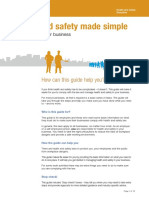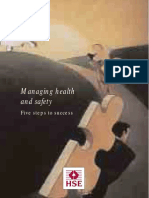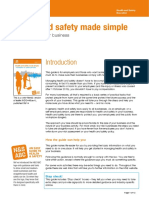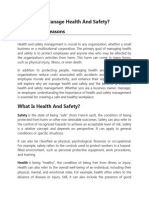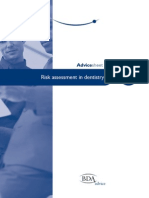The Importance of Study
The Importance of Study
Uploaded by
Jeevaan SritharanCopyright:
Available Formats
The Importance of Study
The Importance of Study
Uploaded by
Jeevaan SritharanOriginal Description:
Original Title
Copyright
Available Formats
Share this document
Did you find this document useful?
Is this content inappropriate?
Copyright:
Available Formats
The Importance of Study
The Importance of Study
Uploaded by
Jeevaan SritharanCopyright:
Available Formats
The Importance of Study
A serious workplace injury or death changes lives forever for families, friends,
communities, and coworkers too. Human loss and suffering is immeasurable. Occupational
injuries and illnesses can provoke major crises for the families in which they occur. In
addition to major financial burdens, they can impose substantial time demands on uninjured
family members. Today, when many families are operating with very little free time, family
resources may be stretched to the breaking point.
Every person who leaves for work in the morning should expect to return home at night in
good health. Can you imagine the knock on the door to tell you your loved one will never be
returning home? Or the phone call to say hes in the hospital and may never walk again?
Ensuring that husbands return to their wives, wives to their husbands, parents to their
children, and friends to their friends that is the most important reason to create a safe and
healthy work environment.
But it isnt the only reason.
REDUCING INJURIES REDUCES COSTS TO YOUR BUSINESS:
If a worker is injured on the job, it costs the company in lost work hours, increased insurance
rates, workers compensation premiums and possible litigation. Productivity is lost when
other workers have to stop work to deal with the injury. Even after the injured employee has
been sent home or taken to the hospital, other employees may be distracted or need to take
time off from work in the aftermath of the incident. Even a single injury can have far-
reaching and debilitating effects on your business.
SAFE WORKERS ARE LOYAL WORKERS:
Any business knows that employee attrition and absenteeism can be major obstacles. When
you create a healthy and safe workplace, you reduce those issues in several ways. By
budgeting for safety improvements and making safety part of your operational plan, you
engender trust. By involving employees in safety decisionsthrough reporting, committees,
walk-throughs and meetingsyou show that their opinion matters to you. By following
through on their input and improving safety, you prove quite tangibly that you care about
their well-being. Workers typically respond by working harder, showing more pride in their
jobs and remaining loyal.
SAFETY IMPROVES QUALITY:
Time and again, companies that put safety first turn out higher quality products. In some
cases, thats because a safe workplace tends to be a more efficient one, free of debris and
tangles of cords. In other cases, its a matter of focus. By working in a clean, efficient
environment, workers are able to reduce distractions and truly focus on the quality of what
they do. The results? Better products that create customer loyalty, bigger margins and
increased sales.
In these ways and others workplace safety is about much more than legislation. Its about
creating the kind of productive, efficient, happy and inspiring workplace we all want to be
part of. Its about creating a highly profitable company. And thats why its important.
Underlying Principles
Attention to health and safety is not just about being socially responsible. It also makes good
business sense and you should regard it as just as important as the achievement of any other
key business objective.
Of course, working out what modern health and safety law means for your business can be
quite a headache. But don't be put off. Yes, on the face of it there do seem to be a lot of
regulations and there is a lot of supporting guidance, but the underlying principles are really
quite straightforward.
Essentially you have to ensure absence of risk to safety and health of employees and others
'so far as is reasonably practicable'.
System in place to Manage Health & Safety
You have to have a system (e.g. have a policy, designate people and have clear
procedures) in place to manage health and safety (and, if you employ more than five
people, set this out in a written health and safety policy statement). You need to be
able to show how you plan, organise, control, monitor and review preventative
measures. And you need to appoint a competent person(s) to help you comply with
your legal obligations.
Identify hazards
You have to identify your main hazards (things that could cause harm).
Assess Risk
You have to assess your risks (the probability that significant harm will occur) and
again, if you employ more than five, record the results of your assessment.
Risk assessment is the key to working out what needs to be done - but don't make it
over-complicated. Remember, although you have to do it by law, it is really only any
use if it can be used as a working tool - to help you prove to yourself and your
employees that you have identified the main things in your business which could
cause harm and that you are doing everything you should to prevent that harm from
happening.
Risk Control Measures
You have to make sure that your risk control measures are adequate and that they are
used and maintained and that they continue to work. (You also have to put in place
any back up measures that may be needed like health surveillance or emergency
procedures). And you have to inform, train and supervise employees.
For the most part the law sets out certain health and safety goals to be achieved and
indicates appropriate 'benchmarks' to help you work out whether your controls are up
to 'reasonably practicable' standards. There is an underlying requirement to reduce or
eliminate hazards at source, or isolate people from them (for example, by guarding
machinery) before using other forms of control. Relying on the use of personal
protective equipment - like respirators or protective footwear - is a last resort and is
only acceptable when all other options have failed.
You also have to:
o report and record accidents;
o provide certain basic workplace, first aid and welfare facilities;
o have employers' liability insurance;
o notify the Health and Safety Executive (HSE) and the Local Authority of your
existence;
o consult your workforce and their representatives; and so on.
Risk Control Measures
For the most part the law sets out certain health and safety goals to be achieved and indicates
appropriate 'benchmarks' to help you work out whether your controls are up to 'reasonably
practicable' standards. There is an underlying requirement to reduce or eliminate hazards at
source, or isolate people from them (for example, by guarding machinery) before using other
forms of control. Relying on the use of personal protective equipment - like respirators or
protective footwear - is a last resort and is only acceptable when all other options have failed.
You might also like
- Fiona Duguid, Karsten Mündel, Daniel Schugurensky (Auth.) - Volunteer Work, Informal Learning and Social Action-SensePublishers (2013)Document252 pagesFiona Duguid, Karsten Mündel, Daniel Schugurensky (Auth.) - Volunteer Work, Informal Learning and Social Action-SensePublishers (2013)Marco Túlio OliveiraNo ratings yet
- (123doc) de Toeic Co Dap An Chi Tiet de 7Document62 pages(123doc) de Toeic Co Dap An Chi Tiet de 7Ngan LttNo ratings yet
- Indg 449Document12 pagesIndg 449kave4923100% (1)
- 51 HR Metrics Cheat Sheet: 51 of The Most Important HR MDocument5 pages51 HR Metrics Cheat Sheet: 51 of The Most Important HR Mreema mohantyNo ratings yet
- Health & Safety Advice Pack For Smaller FirmsDocument4 pagesHealth & Safety Advice Pack For Smaller FirmsLove Craft IINo ratings yet
- Small Business Tips EbookDocument18 pagesSmall Business Tips EbookZeeshan BajwaNo ratings yet
- Five Steps To: Risk AssessmentDocument7 pagesFive Steps To: Risk AssessmentTrongdanh NguyenNo ratings yet
- 5 Steps To Risk AssessmentDocument8 pages5 Steps To Risk AssessmentMYANMAR SEAMEN UNIONNo ratings yet
- Individual Submission Week 11Document5 pagesIndividual Submission Week 11Sachin VSNo ratings yet
- Health and Safety Made Simple: How Can This Guide Help You?Document10 pagesHealth and Safety Made Simple: How Can This Guide Help You?AldrinNo ratings yet
- Wirehouse Employer ServicesDocument7 pagesWirehouse Employer ServicesdedNo ratings yet
- Management SafetyDocument13 pagesManagement SafetyArdhiansyah IvanNo ratings yet
- Health and Safety at The WorkplaceDocument5 pagesHealth and Safety at The WorkplaceAnthonyNo ratings yet
- Managing Safety and HealthDocument7 pagesManaging Safety and Healthtsega-alem berihuNo ratings yet
- Health Health and Safety Made Simple PDFDocument12 pagesHealth Health and Safety Made Simple PDFclick2klicNo ratings yet
- 8 Workplace SafetyDocument8 pages8 Workplace Safetykiptoomaisy26No ratings yet
- Common Risks and Hazards To ClientsDocument3 pagesCommon Risks and Hazards To ClientsTitser Jr Kagura MainNo ratings yet
- Five TIPS TO MANAGE EMPLOYEE RISKDocument4 pagesFive TIPS TO MANAGE EMPLOYEE RISKaswin albertNo ratings yet
- Indg 163Document8 pagesIndg 163api-60715666No ratings yet
- 5 Steps To Risk AssessmentDocument8 pages5 Steps To Risk AssessmentAnnie Hawkins100% (1)
- Report 2.safety and HealthDocument26 pagesReport 2.safety and HealthJoseph Nathan Marquez100% (2)
- RICS Surveying Safely Red Cover - HseDocument16 pagesRICS Surveying Safely Red Cover - HseyohanjNo ratings yet
- Health and Safety Made Simple: How Can This Guide Help You?Document12 pagesHealth and Safety Made Simple: How Can This Guide Help You?Abdeljalil EL KholtiNo ratings yet
- Accident Incident Investigation and ControlDocument6 pagesAccident Incident Investigation and ControlEdmil PabellanoNo ratings yet
- A Safe Workplace Is Sound BusinessDocument16 pagesA Safe Workplace Is Sound BusinessJeremiah MalagueñoNo ratings yet
- Health and Safety Manual TemplateDocument15 pagesHealth and Safety Manual Templatebrenda smith100% (1)
- Health and Safety Made Simple: The Basics For Your BusinessDocument12 pagesHealth and Safety Made Simple: The Basics For Your BusinessgiovadiNo ratings yet
- UV30491 Monitor and Maintain Health and Safety PracticeDocument12 pagesUV30491 Monitor and Maintain Health and Safety Practicekn4xnrg28gNo ratings yet
- Why Do We Manage Health and Safety (Shehzad Zafar)Document9 pagesWhy Do We Manage Health and Safety (Shehzad Zafar)Gebshet WoldetsadikNo ratings yet
- ACTIVITY-2 BUENAVENTURA CpE 3-6Document4 pagesACTIVITY-2 BUENAVENTURA CpE 3-6Celine Joie BuenaventuraNo ratings yet
- Project (Employee Health and Safety)Document72 pagesProject (Employee Health and Safety)lone wolf100% (1)
- HazpakDocument20 pagesHazpakqhseconsultNo ratings yet
- Engineering Ethics Is The Field of System of Moral Principles That Apply To The Practice of EngineeringDocument22 pagesEngineering Ethics Is The Field of System of Moral Principles That Apply To The Practice of Engineeringmostafa elazabNo ratings yet
- Health and Safety WorkbookDocument7 pagesHealth and Safety WorkbookphilgchildNo ratings yet
- Cais25 PDFDocument4 pagesCais25 PDFSpreading KnowledgeNo ratings yet
- Cais25 PDFDocument4 pagesCais25 PDFSpreading KnowledgeNo ratings yet
- Five Steps To Risk AssessmentDocument4 pagesFive Steps To Risk AssessmentIsa GuhilingNo ratings yet
- Pooja Thakur Project FileDocument59 pagesPooja Thakur Project Filevishal chauhanNo ratings yet
- Do You Have Any Information On How To Compile A Health and Safety Policy?Document5 pagesDo You Have Any Information On How To Compile A Health and Safety Policy?Rauf HuseynovNo ratings yet
- Managing Safety and HealthDocument6 pagesManaging Safety and HealthLexter CEmpronNo ratings yet
- Current Plain English Regulatory Documents Distributed by The Local WHS Government RegulatorDocument10 pagesCurrent Plain English Regulatory Documents Distributed by The Local WHS Government RegulatorsalazarayieNo ratings yet
- Managing Risks and Risk Assessment at Work - Useful GuideDocument4 pagesManaging Risks and Risk Assessment at Work - Useful GuideniallNo ratings yet
- Whs Lesson 5Document5 pagesWhs Lesson 5api-279228567No ratings yet
- BSBWHS303Document13 pagesBSBWHS303jljx878No ratings yet
- (Health and Safety Executive (HSE) ) COSHH EssentiaDocument16 pages(Health and Safety Executive (HSE) ) COSHH EssentiaVini AristiantiNo ratings yet
- Health and Safety TrainingDocument4 pagesHealth and Safety TrainingRavi KiranNo ratings yet
- Hse Training Manual OneDocument47 pagesHse Training Manual OneEneyo VictorNo ratings yet
- OSH Foundations and Its BenefitsDocument32 pagesOSH Foundations and Its Benefitselviraandadi14No ratings yet
- Risk Assessment Advice Sheets PDFDocument16 pagesRisk Assessment Advice Sheets PDFvishali sethiNo ratings yet
- The Art of Risk Management: Learn to Manage Risks Like a ProFrom EverandThe Art of Risk Management: Learn to Manage Risks Like a ProRating: 3 out of 5 stars3/5 (1)
- Health and Safety Training: What You Need To KnowDocument6 pagesHealth and Safety Training: What You Need To KnowFrank MacauNo ratings yet
- OTHM Text Book PDFDocument475 pagesOTHM Text Book PDFBsvk DupanaNo ratings yet
- HSG65 Managing for Health and Safety: A revised edition of one of HSE's most popular guidesFrom EverandHSG65 Managing for Health and Safety: A revised edition of one of HSE's most popular guidesRating: 5 out of 5 stars5/5 (2)
- Workplace Health and Safety Management Systems: D.I.Y GuideFrom EverandWorkplace Health and Safety Management Systems: D.I.Y GuideRating: 1 out of 5 stars1/5 (1)
- Unlocking the Hidden Dangers Lurking in Your Restaurant or Café.From EverandUnlocking the Hidden Dangers Lurking in Your Restaurant or Café.No ratings yet
- Dealing with Dismissal: Practical advice for employers and employeesFrom EverandDealing with Dismissal: Practical advice for employers and employeesNo ratings yet
- Redefining Work Health and Safety: Systems, Strategies, and Progressive ApproachesFrom EverandRedefining Work Health and Safety: Systems, Strategies, and Progressive ApproachesNo ratings yet
- It's All About People!: A Practical Guide to Develop a Dynamic Safety CultureFrom EverandIt's All About People!: A Practical Guide to Develop a Dynamic Safety CultureNo ratings yet
- Where do I start? 10 Health and Safety Solutions: A Workbook for Busy Managers, Supervisors & Business OwnersFrom EverandWhere do I start? 10 Health and Safety Solutions: A Workbook for Busy Managers, Supervisors & Business OwnersNo ratings yet
- HSG48 Reducing Error And Influencing Behaviour: Examines human factors and how they can affect workplace health and safety.From EverandHSG48 Reducing Error And Influencing Behaviour: Examines human factors and how they can affect workplace health and safety.No ratings yet
- Classical Theories of WagesDocument2 pagesClassical Theories of WagesRoselle San BuenaventuraNo ratings yet
- Garments ProfileDocument9 pagesGarments ProfileSadman RadNo ratings yet
- Employment Law Assignment 1Document2 pagesEmployment Law Assignment 1Sharon HenryNo ratings yet
- Get Solution Manual For Canadian Organizational Behaviour, 10th Edition Steven McShane Kevin Tasa Free All Chapters AvailableDocument55 pagesGet Solution Manual For Canadian Organizational Behaviour, 10th Edition Steven McShane Kevin Tasa Free All Chapters Availablemassaolitzi57100% (2)
- The Importance of Succession Planning in Organizations: Ershad EstedadiDocument7 pagesThe Importance of Succession Planning in Organizations: Ershad EstedadiRiaz UddinNo ratings yet
- Corporate Social Responsibility Notes - Mod 1 & 2 PDFDocument70 pagesCorporate Social Responsibility Notes - Mod 1 & 2 PDFMadhav RajbanshiNo ratings yet
- Approved Circular D3 of 2023 Revised CircularDocument4 pagesApproved Circular D3 of 2023 Revised Circularspecpro93No ratings yet
- Ethics in The Hospitality IndustryDocument5 pagesEthics in The Hospitality IndustryCaesar DaleNo ratings yet
- Survey On Employee Engagement at Cognizant Technology SolutionsDocument6 pagesSurvey On Employee Engagement at Cognizant Technology SolutionsRaman ShanmugaNo ratings yet
- (56034557) - (Boycod) - (Kurniawan) - Bellboy - Front-Desk-Agent-StaffDocument3 pages(56034557) - (Boycod) - (Kurniawan) - Bellboy - Front-Desk-Agent-StaffMaura GrosirNo ratings yet
- Tanvir SirDocument10 pagesTanvir SirMd. Piar AhamedNo ratings yet
- Tenjin Technologies Offer Letter-2Document1 pageTenjin Technologies Offer Letter-2mdgiri948No ratings yet
- Final Manuscript..Document58 pagesFinal Manuscript..Camille alonNo ratings yet
- Fiji National Vocational Training PolicyDocument24 pagesFiji National Vocational Training Policysisco_meo9772No ratings yet
- Final Project Performance EnhancementDocument55 pagesFinal Project Performance EnhancementNikhil ShrivastavaNo ratings yet
- Payroll Report - End Date 11/04/2015Document32 pagesPayroll Report - End Date 11/04/2015New York SenateNo ratings yet
- Emergency Lighting Design Guide PDFDocument11 pagesEmergency Lighting Design Guide PDFsorry2qaz100% (1)
- FA 1948 With SchedulesDocument60 pagesFA 1948 With SchedulesAlpesh ValaNo ratings yet
- Thesis On Financial Problems of Small Scale Industries in IndiaDocument6 pagesThesis On Financial Problems of Small Scale Industries in Indiacarolynostwaltbillings100% (2)
- HSE Audit ReportDocument22 pagesHSE Audit Reportmunawar hussainNo ratings yet
- CPF Contribution Rates For Jan 2016Document5 pagesCPF Contribution Rates For Jan 2016Kayleen ChewNo ratings yet
- Republic Act NO.8282: Social Security LawDocument29 pagesRepublic Act NO.8282: Social Security LawArbie Dela TorreNo ratings yet
- 2020-TA-c-ALL (Local 241)Document8 pages2020-TA-c-ALL (Local 241)Chicago Transit Justice CoalitionNo ratings yet
- Mu0010 - Manpower Planning and Resourcing-mu0011-Mu0012-Mu0013-Human Resource Smu Summer 2016 Solved AssignmentDocument10 pagesMu0010 - Manpower Planning and Resourcing-mu0011-Mu0012-Mu0013-Human Resource Smu Summer 2016 Solved AssignmentMrinal KalitaNo ratings yet
- Business Plan PDFDocument8 pagesBusiness Plan PDFSavy Visal0% (1)
- Gestion Des Ressources Humaines - Proposition D'un Système de Sauvegarde - Chapter 01 - Resource Planning Human 2Document10 pagesGestion Des Ressources Humaines - Proposition D'un Système de Sauvegarde - Chapter 01 - Resource Planning Human 2IK storeNo ratings yet
- Introduction To Admin Management - Introduction To Office SystemsDocument23 pagesIntroduction To Admin Management - Introduction To Office SystemsBarby Angel100% (1)









